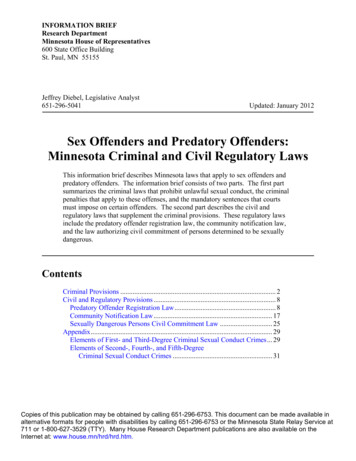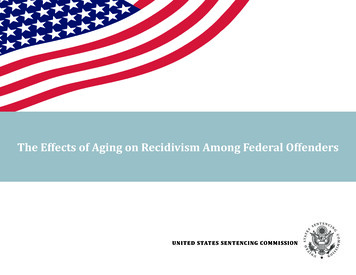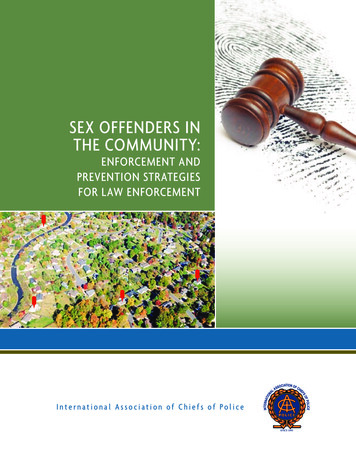
Transcription
Treating Sex Offenders tine Gomes, Psy.D.Brittany West, M.A.Steve Donovan, M.Ed.Amanda Fenrich, M.A.
Sex Offender Treatment Modality Cognitive-behavioral therapy is widely considered to be the mosteffective theoretical orientation to use for sex offender treatment. However, CBT may not be applicable to people with IntellectualDisabilities (IDD) because of emphasis on learning and insight(Keeling, Rose, & Beech, 2006).
Importance of Treating SexOffenders with IDD People with Intellectual Disabilities are over-represented in the criminaljustice system; however, it is unclear whether these people’s cognitive andemotional deficits make them more likely to commit crimes, or if “problembehaviors” typically shown by people with IDD are interpreted byauthorities as criminal. Studies have shown that sexual offenders with IDD recidivate at a higherrate than the general sex offender population (Camilleri & Quinsey, 2011; Heaton & Murphy,2013; Klimecki, Jenkinson, & Wilson, 1994; Lambrick & Glaser, 2004; Lindsay, Elliot, & Astell, 2004; Polascheck, 2003). Hanson & Bussiere (1998) found that sex offenders, in general, recidivate at a rate of13.4%. Two different studies showed much higher rates of recidivism for sex offenders withIDD: 41% and 43%, respectively (Klimecki et al., 1994; Lindsay et al., 2013)
Review of Sex Offender TreatmentPrograms for People with IDD (Marotta,2017) Thorough literature review revealed 18 studies on the effectiveness ofsex offender treatment programs for people with IDD. Programs in the review were based on the following theoreticalorientations: Cognitive Behavioral Therapy (CBT)Problem Solving TherapyDialectical Behavior Therapy (DBT) combined with CBTMindfulnessRelapse Prevention
Cognitive Behavioral Therapy 13 of the 18 studies evaluated were purely CBT interventions Topics covered were: Sex Education, Confidentiality, Pathways into Offending, Legal Details around Offending,Motivation to Offend, Cognitive Distortions, Victim Empathy, Relapse Prevention, Cycle ofOffending, Sexual Fantasy, Masturbation, Assertiveness, Listening Skills, Stimulus Avoidance,and Appropriate Sexual Relationships Treatment was delivered through the following methods: Role plays, Watching Videos, Quizzes, Didactic Presentations, Group Exercises, Games, andGroup Discussions Treatment was modified in the following ways: Reduced time of didactic teaching, increasing number of games played, reducing time ofsessions, allowing for and encouraging questions, incorporating living skills and healthyrelationship training, simplifying concepts, adding more information related to sex education
Cognitive Behavioral Therapy Outcomes When CBT was used, significant treatment gains were shown inknowledge, attitude, cognitive and behavioral measures. Follow-up revealed the following: For behavioral outcomes, the highest rates of reoffending were found whenboth official and unofficial sources were used. One of these studies found a 32% recidivism rate for treated sex offenders with IDD. Compare this to 41% and 43% overall recidivism rates mentioned above. Results regarding cognitive changes showed that these changes may be morelikely to be sustained if treatment lasts for 2 years, rather than 1 year.
Problem Solving Therapy(O’Connor, 1996) In this program, Behavior Chain Analyses (BCA’s) were used to show clients what thethoughts, feelings, and behaviors were that maintained their sexual offending behavior,made it less likely that they would develop healthy relationships, and increased thelikelihood of substance abuse. Problem solving discussions took place regarding many different problems that couldarise in many different situations that may lead to sexual offending behavior. Recidivism data was not available for this study, as there was no follow-up. However, thisapproach found the following outcomes: Reduction in minimization and denial of crimes Increase in knowledge of the consequences of sex offending, coping skills and internal locus ofcontrol Clients were given more access to the community and required less intensive supervision.
Dialectical Behavior Therapy withCBT (Sakdalan & Collier, 2012) Consisted of 2 hour weekly group sessions and 1 hour weeklyindividual psychotherapy Results were: Reduction in risk for sexual violence and attitudes supportive of sexualoffending Increased sexual knowledge and victim empathy These gains were sustained for a year after treatment; however, because there was nocontrol group, it is unclear if the DBT component of the program increased positivetreatment outcomes over and above the CBT components.
Mindfulness (Singh et al., 2011) Mindfulness exercises (meditation to the soles of the feet and mindfulobservation of thoughts) were taught and practiced in weekly, onehour individual sessions. There were only 3 participants in this study; however, all theseparticipants reported that these exercises increased their self-controland reported reductions in deviant sexual arousal at the end of theyear.
Relapse Prevention (Rea et al.,2014) “Companions” accompanied clients out in the community to see if they were able togeneralize the individualized relapse prevention skills they learned in treatment. Skills involved doing an alternative behavior when confronted with a high risk situation Skills that were highly generalized were: Avoiding physical contact with potential victims Avoiding looking at potential victims Skills that were partially generalized were: Looking in the other directionAvoiding potential victims in close proximityAvoiding looking at potential victims from a distanceKeeping distance/selecting routes of travel that would avoid contact with potential victims One skill was poorly generalized, and that was avoiding locations where potential victimscongregate. (This is interesting, because it seems like an easy one).
WA DOC SOTAP Activity Track There are currently 3 treatment groups within WA DOC SOTAP thatare designed to serve SOTAP clients with IDD. Treatment concepts are adapted in many of the ways listed in theliterature review. A work group is currently working on an Activity Track Manual thatwill include a literature review and a variety of activities therapistscan facilitate in their groups. The goal of the manual is the standardization of Activity Track groups.
Observed Differences fromNeurotypical Clients Informed Consent looks different The process may require more time to poll for comprehension Documentation language may need to be explained overall Psychological testing is extremely helpful to establish baselines ofcomprehension and cognitive abilities Psychoeducational and didactic sessions may require slower pacingand reiteration of concepts more often Abstract concepts may require additional time. Analogies, often with concretesymbolism, have been helpful Emphasis of skill development, notably problem solving Supports are often needed in the development of approach goals
Autobiography/Sexual HistoryTimeline Across a whiteboard or large piece of paper, draw a time line ranging fromzero until the client’s current age. Briefly gather information about familyconstellation order, and short narratives about members of the householdand relationship interactions. Significant Life Events Births, deaths, significant relationships, geographical moves, etc. Inquire as to why the client believes they are significant One way to preface the activity is to explain what might be a significant event is one that hashad an impact that has been “helpful” or “not helpful” or even “harmful.” Sexual Experience History Does the client believe these experiences to be healthy and appropriate? Why? Legal History and Substance Abuse History Treatment History Trauma History
Volcano ActivityPossible Positive OutcomesAKA“the Good Life”Negative Behavioral OutcomesNegative Core BeliefsHigh Risk FactorsPositive Core BeliefsProtective Factors
Value Sort Activity Having a visual representation of sorting out which values are mostimportant resonates with some clients who are spatial or tactile learners. Ithas been necessary to define some values with concrete examples; briefdefinitions might be included on the value cards. It might also be helpful toinclude a picture or symbol for visual recognition, especially for thoseclients who cannot read. Three categories are identified: Values that VERY IMPORTANT, IMPORTANT,and NOT IMPORTANT. The client divides the value cards into the threecategories. The focus will be on the category of VERY IMPORTANT, althoughthe ones identified in the other categories may be of clinical significance.Finding out why a value is NOT IMPORTANT, especially if relevant to theoffense behavior, can give you a great deal of information. The client thenidentifies which five values are the most important in the VERYIMPORTANT category. It may be helpful to have the client rank them.
Social Influences Inventory Across a whiteboard, draw a line with one end being “Positive” and the otherbeing “Negative.” The midpoint is labelled “Neutral.” Gather information aboutsupport people, both in the community and perhaps other inmates. Data toinclude would be legal and substance abuse histories, knowledge of the indexoffense, attitudes towards treatment, and general questions about frequency andquality of contact with this individual. Using the information just discussed, have the client place/write the supportperson’s name on the continuum, whether it be positive, negative, or neutral.Some adjustment of placement of names will probably be necessary as theactivity progresses. For example, ask if Person A is positive or negative, or neutral.Have the client explain why this person falls into one category or another. To theside, make note of how the client conceptualizes positive or negative. Repeat thisprocess regarding Person B. Afterwards, have client evaluate in what ways PersonA and Person B are alike and how they differ. Have client determine which one ismore positive or negative and their rationale as to why.
Social Influences Inventory Repeat the process until all support persons have been evaluated. Payattention to the reasons articulated. Explore how they coincide ordiffer from identified values held. Using those reasons, explore howthese criteria might be used in evaluating future social influences. For example, this is what one client identified this being a mostpositive influence: “Someone that does not use alcohol or drugs” “Someone that does not abuse me physically or sexually” “Someone that helps me with problems, but does not take advantage of me”
Mixed EmotionsUnderstanding dynamic risk factors and identifyingemotions.Disclaimer: The Mixed Emotioncards are a tool to conveytreatment concepts and DOCSOTAP is not making a profit fromusing them.
The mixed emotions cards are visualrepresentations of various emotions. Each cardcontains 4 words for a specific emotion.
How does it work?Using the mixed emotions cards as visual aids, pick 3-5 cards tocreate a themeFor example: Hateful (hostile, vengeful,spiteful), angry (mad, furious, enraged),and hopeless (pessimistic, despondent,defeated) could be grouped together.Explain to the group that they are to look atthe set of cards and identify which DRF itmost closely relates to. In the case of thesecards, it could be linked to negativeemotionality.
Negative Emotionality
Social Rejection and Loneliness
Help the client gain understanding of different values The Good Lives model helps decrease recidivism for sexual offenders Strength based theory (Ward, Gobbels, & Willis, 2014). Sex offenders also try to meet goals in life to help them achieve a balanced life(Yates, Prescott, & Ward, 2010). It helps the clients clarify and commit to living according to their values More simply asking the client, “what is important to you?”
Example 1: Prior to incarcerationUsing drugsSleepingWorkingIn and out of jailAssociating with negative influencesWatching television
TREATMENTPROVIDERWalk awayDOC/PoliceMake aphone callSomethingelse?
Treatment provider- PinkGo with family/friends-RedStay/Nothing wrong withsituation- WhiteMake a phone call- BlackSomething else- OrangeWalk away- PurpleYou decided to go to college. You have wanted togain more education. You stopped at theenrollment office on your way home from work oneday.It’s Halloween and your employer has decidedthey want to pass out candy to trick-ortreaters. Do you stay at work or leave?Something else?Your cell phone broke and you really need tomake a few calls. Your friend offers to loanyou his/her phone. Do you use the phone?You have a reserved ticket (seat) on anairplane and it’s very important you getwhere you are going. There are no extra seatsand you find you are sitting next to a womanwith three children. What do you do?
Think Sheet
Problem-Solving Wheel
Coping Skills
ReferencesCamilleri, J.A., & Quinsey, V.L. (2011). Appraising the risk of sexual and violent recidivism amongintellectually disabled offenders. Psychology, Crime & Law, 17, 59-74.Craig, L.A., Stringer, I., & Sanders, C.E. (2012). Treating sexual offenders with intellectual limitations inthe community. The British Journal of Forensic Practice, 14, 5-20.Heaton, K.M., & Murphy, G.H. (2013). Men with intellectual disabilities who have attended sex offendertreatment groups: A follow-up. Journal of Applied Research in Intellectual Disabilities, 26, 489500.Keeling, J.A., Rose, J.L., & Beech, A.R. (2006). A comparison of the application of the self-regulationmodel of the relapse process for mainstream and special needs offenders. Sexual Abuse: AJournal of Research and Treatment, 18, 373-382.Keeling, J.A., Rose, J.L., & Beech, A.R. (2007). Comparing sexual offender treatment efficacy: Mainstreamsexual offenders and sexual offenders with special needs. Journal of Intellectual andDevelopmental Disability, 32, 117-124.Klimecki, M.R., Jenkinson, J., & Wilson, L. (1994). A study of recidivism among offenders with anintellectual disability. Australia and New Zealand Journal of Developmental Disabilities, 19, 209219.
ReferencesLambrick, F., & Glaser, W. (2004). Sex offenders with an intellectual disability. Sexual Abuse: AJournal of Research and Treatment, 16(4), 381-392.Langdon, P.E., Maxted, H., Murphy, G.H., & Group, S.I. (2007). An exploratory evaluation of the Wardand Hudson offending pathways model with sex offenders who have intellectual disability.Journal of Intellectual & Developmental Disability, 32, 94-105.Lindsay, W.R., & Smith, A.H. (1998). Responses to treatment for sex offenders with intellectualdisability: A comparison of men with 1- and 2-year probation sentences. Journal of IntellectualDisability Research, 42, 346-353.Lindsay, W.R., Michie, A.M., Steptoe, L., Moore, F., & Haut, F. (2011). Comparing offenders againstwomen and offenders against children on treatment outcome in offenders with intellectualdisability. Journal of Applied Research in Intellectual Disabilities, 24, 361-369.Lindsay, W.R., Steptoe, L., Wallace, L., Haut, F., & Brewster, E. (2013). An evaluation and 20 yearfollow- up of a community forensic intellectual disability service. Criminal Behaviour and MentalHealth, 23, 138-149.Lindsay, W.R., Elliot, S.F., & Astell, A. (2004). Predictors of sexual offence recidivism in offenders withintellectual disabilities. Journal of Applied Research in Intellectual Disabilities, 17, 299-305.
ReferencesMarotta, P.L. (2017). A systematic review of behavioral health interventions for sex offenders withintellectual disabilities. Sexual Abuse: A Journal of Research and Treatment, 29 (2), 148185.Murphy, G.H., Powell, S., Guzman, A.M., & Hays, S.J. (2007). Cognitive-behavioral treatment for menwith intellectual disabilities and sexually abusive behavior: A pilot study. Journal ofIntellectual Disability Research, 51, 902-912.Murphy, G.H., Sinclair, N., Hays, S.J., Heaton, K., Powell, S., Langdon, P., Craig, L. (2010).Effectiveness of group cognitive behavioral treatment for men with intellectual disabilitiesat risk of sexual offending. Journal of Applied Research in Intellectual Disabilities, 23, 537551.O’Connor, W. (1996). A problem-solving intervention for sex offenders with an intellectual disability.Journal of Intellectual and Developmental Disability, 21, 219-235.Polascheck, D.L. (2003). Relapse prevention, offense process models, and the treatment of sexualoffenders. Professional Psychology: Research and Practice, 34, 361-367.
ReferencesRea, J.A., Dixon, M.R., & Zettle, R.D. (2014). Assessing the generalization of relapse-preventionbehaviors of sexual offenders diagnosed with an intellectual disability. BehaviorModification, 38, 25-44.Rose, J., Jenkins, R., O’Connor, C., Jones, C., & Felce, D. (2002). A group treatment for men withintellectual disabilities who sexually offend or abuse. Journal of Applied Research inIntellectual Disabilities, 15, 138-150.Rose, J., Rose, D., Hawkins, C., & Anderson, C. (2012). A sex offender treatment group for menwith intellectual disabilities in a community setting. The British Journal of Forensic Practice,14, 21-28.Sakdalan, J.A., & Collier, V. (2012). Piloting an evidence-based group treatment program for highrisk sex offenders with intellectual disability in the New Zealand setting. New ZealandJournal of Psychology, 41(3), 5-11.Singh, N.N., Lancioni, G.E., Winston, A.S., Singh, A.N., Adkins, A.D., & Singh, J. (2011). Can adultoffenders with intellectual disabilities use mindfulness-based procedures to control theirdeviant sexual arousal? Psychology, Crime & Law, 17, 165-179.
justice system; however, it is unclear whether these people's cognitive and emotional deficits make them more likely to commit crimes, or if "problem behaviors" typically shown by people with IDD are interpreted by authorities as criminal. Studies have shown that sexual offenders with IDD recidivate at a higher










